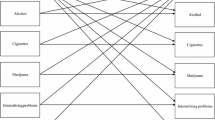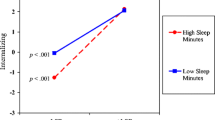Abstract
Victimization is linked to externalizing outcomes in adolescents and recent theorizing suggests that sleep plays a role in this relationship; however, there is little evidence examining sleep as a mediator. This study examines associations between victimization experiences and changes in aggression, delinquency, and drug use. Data were obtained from three waves of a school-based study with middle-school youth (n = 785; 55 % female; 20 % African American; M = 12.32, SD = .51 years at T1), and path analyses were used to test the key hypotheses. Analyses controlling for major life events, demographic factors, and school site revealed that victimization indirectly affected delinquency and drug use, but not aggression, through its relationship with sleep problems. Further, the effects of sleep problems on drug use were specific to females. These data suggest that intervening to address sleep problems resulting from victimization may serve to reduce some forms of externalizing behavior.



Similar content being viewed by others
References
Astill, R. G., Van der Heijden, K. B., Van Ijzendoorn, M. H., & Van Someren, E. J. (2012). Sleep, cognition, and behavioral problems in school-age children: A century of research meta-analyzed. Psychological Bulletin, 138, 1109–1138.
Bandura, A. (1986). Social foundations of thought and action: A social cognitive theory. Prentice-Hall, Inc.
Becker, S. P., Langberg, J. M., & Byars, K. C. (2015). Advancing a biopsychosocial and contextual model of sleep in adolescence: A review and introduction to the special issue. Journal of Youth and Adolescence, 44, 239–270.
Bentler, P. M. (1992). On the fit of models to covariances and methodology to the Bulletin. Psychological Bulletin, 112, 400–404.
Bongers, I. L., Koot, H. M., van der Ende, J., & Verhulst, F. C. (2004). Developmental trajectories of externalizing behaviors in childhood and adolescence. Child Development, 75, 1523–1537.
Browne, M. W., & Cudeck, R. (1993). Alternative ways of assessing model fit. In K. A. Bollen & J. S. Long (Eds.), Testing structural equations models (pp. 136–162). Newbury Park, CA: Sage.
Bub, K. L., Buckhalt, J. A., & El-Shiekh, M. (2011). Children’s sleep and cognitive performance: A cross domain analysis of change over time. Developmental Psychology, 47, 1504–1514.
Catrett, C. D., & Gaultney, J. F. (2009). Possible insomnia predicts some risky behaviors among adolescents when controlling for depressive symptoms. Journal of Genetic Psychology, 170, 287–309.
Clinkinbeard, S. S., Simi, P., Evans, M. K., & Anderson, A. L. (2011). Sleep and delinquency: Does the amount of sleep matter? Journal of Youth and Adolescence, 40, 916–930. , 213–224.
Dodge, K. A., & Somberg, D. R. (1987). Hostile attributional biases among aggressive boys are exacerbated under conditions of threats to the self. Child Development, 58, 213–224.
El-Sheikh, M., Bub, K. L., Kelly, R. J., & Buckhalt, J. A. (2013). Children’s sleep and adjustment: A residualized change analysis. Developmental Psychology, 49, 1591–1601.
El-Sheikh, M., Kelly, R. J., Buckhalt, J. A., & Hinnart, J. B. (2010). Children’s sleep and adjustment over time: The role of socioeconomic context. Child Development, 81, 870–883.
Farrell, A. D., Kung, E. M., White, K. S., & Valois, R. F. (2000). The structure of self-reported aggression, drug use, and delinquent behaviors during early adolescence. Journal of Clinical Child Psychology, 29, 282–292.
Finkelhor, D., Tuner, H. A., Shattuck, A., & Hamby, S. L. (2013). Violence, crime, and abuse exposure in a national sample of children and youth: An update. Journal of the American Medical Association Pediatrics, 164, 238–242.
Finkelhor, D., Turner, H., Ormrod, R., & Hamby, S. L. (2010). Trends in childhood violence and abuse exposure: Evidence from 2 national surveys. Archives of Pediatrics and Adolescent Medicine, 164, 238–242.
Fowler, P. J., Tompsett, C. J., Braciszewski, J. M., Jacques-Tiura, A. J., & Baltes, B. B. (2009). Community violence: A meta-analysis on the effect of exposure and mental health outcomes of children and adolescents. Development and Psychopathology, 21, 227–259.
Ge, X., Natsuaki, M. N., & Conger, R. D. (2006). Trajectories of depressive symptoms and stressful life events among male and female adolescents in divorced and nondivorced families. Developmental Psychopathology, 18, 253–273.
Gregory, A. M., & O’Connor, T. G. (2002). Sleep problems in childhood: A longitudinal study of developmental change and association with behavioral problems. Journal of the American Academy of Child and Adolescent Psychiatry, 41, 964–971.
Gregory, A. M., Van der Ende, J., Willis, T. A., & Verhulst, F. C. (2008). Parent-reported sleep problems during development and self-reported anxiety/depression, attention problems, and aggressive behavior later in life. Archives of Pediatrics and Adolescent Medicine, 162, 330–335.
Gruber, R., Cassoff, J., Frenette, S., Wiebe, S., & Carrier, J. (2012). Impact of sleep extension and restriction on children’s emotional lability and impulsivity. Pediatrics, 130, 1155–1161.
Hu, L. T., & Bentler, P. M. (1999). Cutoff criteria for fit indexes in covariance structure analysis: Conventional criteria versus new alternatives. Structural Equation Modeling: A Multidisciplinary Journal, 6, 1–55.
Ireland, J. L., & Culpin, V. (2006). The relationship between sleeping problems and aggression, anger, and impulsivity in a population of juvenile and young offenders. Journal of Adolescent Health, 38, 649–655.
Jackson, D. L., Gillaspy, J. A., & Purc-Stephenson, R. (2009). Reporting practices in confirmatory factor analysis: An overview and some recommendations. Psychological Methods, 14, 6–23.
Johnson, E. O., & Breslau, N. (2001). Sleep problems and substance use in adolescence. Drug and Alcohol Dependence, 64, 1–7.
Kliewer, W., & Lepore, S. J. (2014). Exposure to violence, social cognitive processing, and sleep problems in urban adolescents. Journal of Youth and Adolescence, 44, 507–517.
Kliewer, W., Lepore, S. J., Oskin, D., & Johnson, P. D. (1998). The role of social and cognitive processes in children’s adjustment to community violence. Journal of Consulting and Clinical Psychology, 66, 199–209.
Lepore, S. J. (1992). Social conflict, social support, and psychological distress: Evidence of cross-domain buffering effects. Journal of Personality and Social Psychology, 63, 857–867.
Lepore, S. J. (1997). Expressive writing moderates the relation between intrusive thoughts and depressive symptoms. Journal of Personality and Social Psychology, 73, 1030–1037.
Lepore, S. J., & Kliewer, W. (2013). Violence exposure, sleep disturbance, and poor academic performance in middle school. Journal of Abnormal Child Psychology, 41, 1179–1189.
Lepore, S. J., Silver, R. C., Wortman, C. B., & Wayment, H. A. (1996). Social constraints, intrusive thoughts, and depressive symptoms among bereaved mothers. Journal of Personality and Social Psychology, 70, 271–282.
Lepore, S. J., & Smyth, J. M. (Eds.). (2002). The writing cure: How expressive writing promotes health and emotional well-being. Washington, DC: American Psychological Association.
McDonald, C. C., & Richmond, T. R. (2008). The relationship between community violence exposure and mental health symptoms in urban adolescents. Journal of Psychiatric and Mental Health Nursing, 15, 833–849.
McKnight-Eily, L. R., Eaton, D. K., Lowry, R., Croft, J. B., Presley-Cantrell, L., & Perry, G. S. (2011). Relationships between hours of sleep and health-risk behaviors in US adolescent students. Preventive Medicine, 53, 271–273.
Moran, A. M., & Everhart, D. E. (2012). Adolescent sleep: Review of characteristics, consequences, and intervention. Journal of Sleep Disorders: Treatment and Care, 1, 1–8.
Mrug, S., Madan, A., & Windle, M. (2012). Temperament alters susceptibility to negative peer influence in early adolescence. Journal of Abnormal Child Psychology, 40, 201–209.
Muthen, L. K., & Muthen, B. O. (1998–2012). Mplus user’s guide (7th ed.). Los Angeles, CA: Muthen & Muthen.
Pasch, K. E., Laska, M. N., Lytle, L. A., & Moe, S. G. (2010). Adolescent sleep, risk behaviors, and depressive symptoms: Are they linked? American Journal of Health Behavior, 34, 237–248.
Pasch, K. E., Latimer, L. A., Cance, J. D., Moe, S. G., & Lytle, L. A. (2012). Longitudinal bi-directional relationships between sleep and youth substance use. Journal of Youth and Adolescence, 41, 1184–1196.
Peach, H. D., & Gaultney, J. F. (2013). Sleep, impulse control, and sensation-seeking predict delinquent behavior in adolescents, emerging adults, and adults. Journal of Adolescent Health, 53, 293–299.
Pieters, S., Burk, W. J., Van der Vorst, H., Dahl, R. E., Wiers, R. W., & Engels, R. C. (2015). Prospective relationships between sleep problems and substance use, internalizing and externalizing problems. Journal of Youth and Adolescence, 44, 379–388.
Pieters, S., Van Der Vorst, H., Burk, W. J., Wiers, R. W., & Engels, R. C. (2010). Puberty-dependent sleep regulation and alcohol use in early adolescents. Alcoholism, Clinical and Experimental Research, 34, 1512–1518.
Raftery, A. E. (1993). Bayesian model selection in structural equation models. In K. A. Bollen & J. S. Long (Eds.), Testing structural equations models (pp. 163–180). Newbury Park, CA: Sage.
Reijntjes, A., Kamphius, J. H., Prinzie, P., Boelen, P. A., van der Shoot, M., & Telch, M. J. (2011). Prospective linkages between peer victimization and externalizing problems in children: A meta-analysis. Aggressive Behavior, 37, 215–222.
Richters, J. E., & Saltzman, W. (1990). Survey of exposure to community violence: Self report version. Rockville, MD: National Institute of Mental Health.
Rubens, S. L., Fite, P. J., Cooley, J. L., & Canter, K. S. (2014). The role of sleep in the relation between community violence exposure and delinquency among Latino adolescents. Journal of Community Psychology, 42, 723–734.
Schumacker, R. E., & Lomax, R. G. (2004). A beginner’s guide to structural equation modeling. Mahwah, NJ: Lawrence Erlbaum.
Tabachnick, B. G., & Fidell, L. S. (2007). Using multivariate statistics (5th ed.). Boston, MA: Allyn and Bacon.
van Geel, M., Goemans, A., & Vedder, P. H. (2016). The relationship between peer victimization and sleeping problems: A meta-analysis. Sleep Medicine Review, 16, 129–136.
Winston, F. K., Puzino, K., & Romer, D. (2015). Precise prevention: Time to move beyond universal interventions. Injury Prevention, 2015, 1–5.
Wolfson, A. R., & Carskadon, M. A. (1998). Sleep schedules and daytime functioning in adolescents. Child Development, 69, 875–887.
Wong, M. M., Brower, K. J., & Zucker, R. A. (2009). Childhood sleep problems, early onset of substance use and behavioral problems in adolescence. Sleep Medicine, 10, 787–796.
Zimmerman, G. M., & Posick, C. (2016). Risk factors for and behavioral consequences of direct versus indirect exposure to violence. American Journal of Public Health, 106, 178–188.
Acknowledgments
This research was supported by National Institute of Mental Health Grant R01MH081166-01A1 awarded to Wendy Kliewer and Stephen J. Lepore. We thank the research staff, schools, teachers, and students who participated in this study.
Authors’ Contributions
D.S. and W.K. jointly conceived and designed the study, D.S. ran the analyses, interpreted the data, and composed the original draft of the manuscript. W.K. and S.L. selected study measures, supervised data collection, and provided feedback and assistance with drafts of the manuscript. All authors approved the final manuscript.
Author information
Authors and Affiliations
Corresponding author
Ethics declarations
Conflict of Interest
The authors report no conflict of interests.
Ethical Approval
The study was approved by the Institutional Review Boards at Virginia Commonwealth University (VCU) and Temple University (TU). All procedures performed in this study were in accordance with the ethical standards of Virginia Commonwealth University and Temple University and with the 1964 Helsinki declaration and its later amendments of comparable ethical standards.
Informed Consent
Written informed consent was provided by the maternal caregiver and assent was provided by the adolescent before initiating the data collection.
Rights and permissions
About this article
Cite this article
Sosnowski, D.W., Kliewer, W. & Lepore, S.J. The Role of Sleep in the Relationship Between Victimization and Externalizing Problems in Adolescents. J Youth Adolescence 45, 1744–1754 (2016). https://doi.org/10.1007/s10964-016-0506-2
Received:
Accepted:
Published:
Issue Date:
DOI: https://doi.org/10.1007/s10964-016-0506-2




